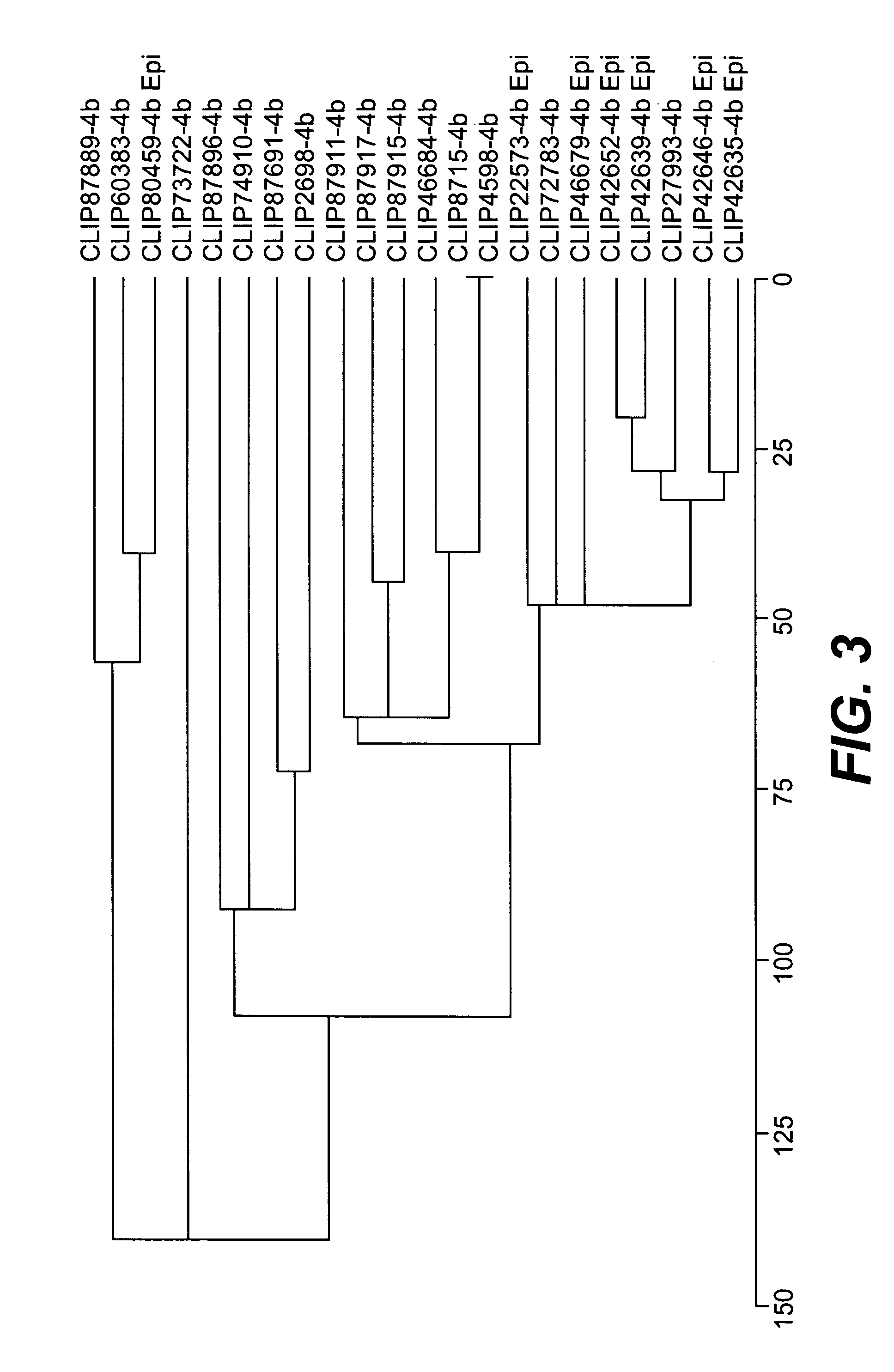Molecular typing of listeria monocytogenes, hybridization supports and kits for said molecular typing
- Summary
- Abstract
- Description
- Claims
- Application Information
AI Technical Summary
Problems solved by technology
Method used
Image
Examples
Example
Example I
Construction of a Macroarray Comprising Genes from Epidemic L. monocytogenes, L. monocytogenes EGDe and L. innocua Strains
[0146] The 2906 kb long genome sequence of the epidemic L. monocytogenes sv 4b strain CLIP80459 (lineage II) was compared to the complete 2944 kb long genome sequence of L. monocytogenes EGDe (sv 1 / 2a, lineage I). 163 of the 2788 CLIP80459 genes (including 13 pseudogenes) were missing in EGDe. (The sequences of these genes have been assigned SEQ ID NOS: 1-163 and are presented in the attached Table 3. The amino acid sequences of the proteins encoded by the open reading frames (ORF) of these genes have been assigned SEQ ID NOS: 164-326 and are presented in the attached Table 4.) Thus, the genetic diversity between the two L. monocytogenes isolates is about 6%, quite close to that between L. monocytogenes EGDe and L. innocua (10.5%), which belong to two different species. The CLIP80459-specific genes include 14 surface proteins with an LPXTG motif, 14 AB...
Example
Example II
Strain Diversity and Overall Gene Distribution
[0149] Based on the macroarray hybridization data predicting the presence or absence of the studied genes, bifurcating trees illustrating possible phylogenetic relationships between the different Listeria were constructed, using the neighbor joining method. Important gene conservation within each species of the genus Listeria and within distinct groups of L. monocytogenes strains was identified. The analysis grouped all strains without exception according to their species. Thus, the Listeria array allows accurate species identification, although the probes were defined from only two Listeria species. Each species was defined by a combination of genes specifically present or absent.
[0150] For the species L. monocytogenes 30 marker genes were identified, 18 that were present in all 93 L. monocytogenes strains tested (Table 9, group I), and absent in all other isolates of the remaining Listeria species, and 12 that were present...
Example
Example III
Sub-Grouping Within the Species L. monocytogenes
[0152] The neighbor-joining method and hierarchical clustering (J-Express) were applied to identify specific gene clusters. Analysis of the 93 L. monocytogenes strains defined three lineages (I, II, and III) and distinguished two subdivisions within each lineage (FIG. 1). For each lineage and subgroup, specific markers were identified.
[0153] Nineteen genes were associated specifically with lineage I (Table 10, group A). Twelve of these genes clustered in two regions coding for proteins putatively involved in sugar metabolism (Imo0734-Imo0739 and Imo1968-Imo1974). Furthermore, a two-component regulatory system (Imo1060, Imo1061), an ABC transporter complex (Imo1062, Imo1063) and a gene coding for a surface protein containing an LPXTG motif (Imo0171) were lineage I-specific. Surprisingly, the bvr locus (bvrABC) (14) was present only in isolates of lineage I and in the two 4c strains. Eight genes allowed the sub-division of ...
PUM
| Property | Measurement | Unit |
|---|---|---|
| Fraction | aaaaa | aaaaa |
| Fraction | aaaaa | aaaaa |
| Force | aaaaa | aaaaa |
Abstract
Description
Claims
Application Information
 Login to View More
Login to View More - R&D
- Intellectual Property
- Life Sciences
- Materials
- Tech Scout
- Unparalleled Data Quality
- Higher Quality Content
- 60% Fewer Hallucinations
Browse by: Latest US Patents, China's latest patents, Technical Efficacy Thesaurus, Application Domain, Technology Topic, Popular Technical Reports.
© 2025 PatSnap. All rights reserved.Legal|Privacy policy|Modern Slavery Act Transparency Statement|Sitemap|About US| Contact US: help@patsnap.com



